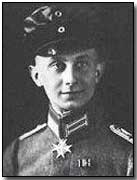Name: Frank Linke-Crawford
Order of the Iron Crown Frank Linke-Crawford
Country: Austro-Hungarian Empire
Rank: Oberleutnant
Units: Flik 12, 41J, 60J
Victories: 27
Born: 18 August 1893
Place of Birth: Krakau (Cracow, Poland)
Killed In Action: 30 July 1918 Killed In Action
Place of Death: Near Guia
Cemetery: Kommunalfriedhof, Salzburg, Austria
After serving with a calvary regiment on the Russian front, Frank Linke-Crawford transferred to the Army Air Service in December 1915 and attended pilot's school in September 1916. Posted to Flik 12 in January 1917, he flew numerous reconnaissance and bombing missions on the Isonzo front. Flying an Aviatik C.I (37.08) without an observer, he was shot down on 2 August 1917, probably by Pier Piccio. On 4 August 1917, Linke was posted to Flik 41J and scored 13 victories by the end of the year. He assumed command of Flik 60J at the end of December 1917 and he scored 14 more victories before he was killed in action on the morning of 30 July 1918. Flying an Aviatik D.I, der Falke von Feltre (the Falcon of Feltre) was shot down by two Italian Hanriot HD.1 fighters from 81a Squadriglia. After the war, Linke's body was recovered and reinterred in Austria.
"Linke was both a fine flier and a fine man. He gave his men full support and generally ignored the rules about officers and non-officers having little to do with each other. He often gave away victories to other, less experienced pilots. As you can imagine, the feelings of his men for him were quite strong." Julius Arigi to Dr. Martin O'Connor, 6 October 197
www.theaerodrome.com/aces/austrhun/linke-crawford.php

























